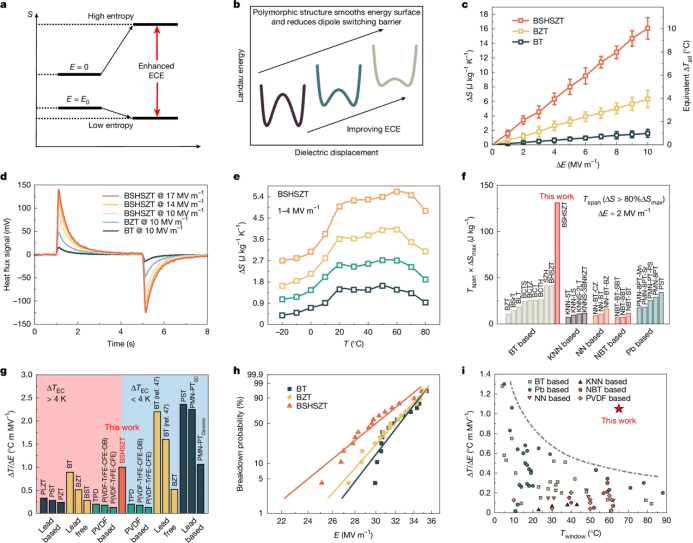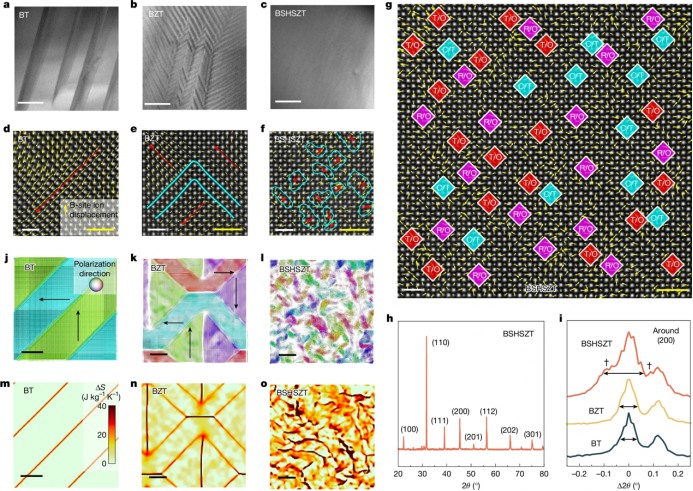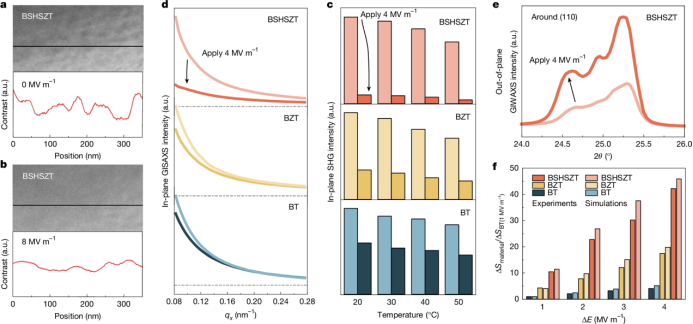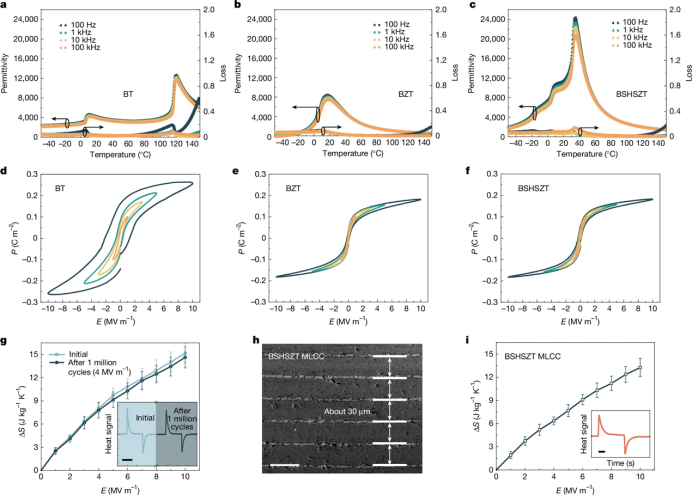On April 9, a team led by Professor Xiaoshi Qian from the Prospective Cross-Research Center at Shanghai Jiao Tong University’s (SJTU) School of Mechanical Engineering published a research paper titled "Giant electrocaloric effect in high-polar-entropy perovskite oxides" in Nature. This paper was co-authored with Professor Shujun Zhang from the University of Wollongong, Australia. The research team designed and synthesized a lead-free perovskite oxide which featured a high-polar-entropy state that exhibited a giant electrocaloric effect. The research reveals its underlying structure-property relationship and offers a new approach to material design for next-generation refrigeration technologies.
The research involves simultaneously substituting multiple elements at both A and B sites in barium titanate ceramics, inducing lattice-level disorder and creating what they term a “high-polar-entropy ceramic.” This structure significantly enhances the giant electrocaloric effect in lead-free ferroelectric ceramics. The work demonstrates a cross-scale fabrication strategy for multilayer electrocaloric refrigerants and proposes a new design framework for future solid-state cooling systems .
Professor Xiaoshi Qian and Professor Shujun Zhang are the corresponding authors. Ph.D. student Feihong Du and Associate Professor Tiannan Yang from the School of Mechanical Engineering are co-first authors.
The electrocaloric effect refers to the reversible entropy change of polar dielectrics when an electric field is applied, leading to heating or cooling-similar to how conventional refrigeration uses phase changes in fluids. Electrocaloric cooling, however, relies on solid-state phase transitions and offers advantages such as zero greenhouse gas emissions, high efficiency, and scalability.
Historically, high-performance electrocaloric ceramics have relied on lead and scandium—elements that raise environmental and cost concerns. To address this, the researchers pursued a lead-free solution based on their earlier Landau phenomenological model for ferroelectric materials. They engineered a relaxor ferroelectric ceramic (BSHSZT, Ba0.8Sr0.2Hf0.025Sn0.025Zr0.025Ti0.925O3) with highly disordered polar structures, effectively inducing numerous switchable polar and non-polar regions. The presence of these atomic-scale polar nanodomains increased domain wall density, further enhancing the material’s polar entropy, thereby boosting the electrocaloric response.
Compared to more conventional polar structures such as barium titanate (BT, BaTiO3) and barium zirconate titanate (BZT, BaZr0.2Ti0.8O3), the high-polar-entropy ceramic (BSHSZT) exhibited a stronger electrocaloric effect and a broader operating temperature range. Under a 10 MV m⁻¹ electric field, the material of the high-polar-entropy oxide exhibited a tenfold increase in entropy change (~15 J kg⁻¹ K⁻¹), along with a working temperature range spanning over 60 °C near room temperature (Fig. 1).
This high-polar-entropy oxide features an ultra-fine, multiphase-coexisting lattice structure, high breakdown field strength, and stable cycling performance exceeding 1 million cycles.

Fig. 1. Design and key properties of "high-polar-entropy" electrocaloric ceramics.
Through structural characterization techniques such as transmission electron microscopy (TEM) and X-ray diffraction (XRD), the researchers confirmed that BSHSZT has a more disordered polar structure than BT and BZT. As element substitution at the A or B sites increased lattice disturbance, the large ferroelectric domains in BT first fragmented into smaller, interwoven domains in BZT and further degenerated into polar clusters consisting of only a few lattices in the high-polar-entropy BSHSZT ceramic. These polar clusters are much smaller than conventional polar nanoregions and exhibit varying polarization directions. Phase-field simulations revealed that the interfaces between these clusters respond strongly to electric fields, accounting for the material’s giant entropy change and its pronounced electrocaloric effect (Fig. 2).

Fig. 2. Ultra-fine, highly disordered polar structure in "high-polar-entropy" electrocaloric ceramics.
This high-polar-entropy strategy for inorganic materials effectively increases the electric-field-induced entropy change while reducing the energy barrier for phase transitions. The team further characterized the evolution of polar structures in inorganic ferroelectric ceramics under an in-situ electric field. TEM images showed that the disordered polar clusters in BSHSZT more readily undergo domain merging and polarization flipping under an electric field. Additionally, grazing-incidence small-angle X-ray scattering (GISAXS) and second-harmonic generation (SHG) measurements showed a greater signal reduction in BSHSZT than in BT or BZT under the same conditions, confirming its lower polarization switching barrier (Fig. 3).

Fig. 3. Evolution of polar structures in inorganic ferroelectric ceramics under an electric field.
BSHSZT also demonstrated a significantly higher dielectric constant than that of BT and BZT, supporting its higher electric-field responsiveness. Its polarization strength under high electric fields did not change significantly, indicating that the enhanced electrocaloric effect stems from increased zero-field polar entropy rather than improved polarization under finite fields. The researchers further fabricated ceramic multilayer capacitors using BSHSZT, reducing driving voltage and significantly improving refrigeration capacity. The electrocaloric effect strength of BSHSZT is 1000% that of BT and 250% that of BZT, with its stable cycles exceeding 1 million times. Its electrocaloric effect operated reliably within a 15–75 °C window (Fig. 4), demonstrating excellent temperature stability near room temperature.

Fig. 4. Dielectric properties and cross-scale fabrication of multilayer electrocaloric refrigerants.
This study received support from multiple research teams, including Associate Researcher Zhengqian Fu (Shanghai Institute of Ceramics), Professor Shengyi Zhong (SJTU Paris Elite Institute of Technology and School of Materials Science and Engineering, SJTU), Professor Dong Qian (School of Physics and Astronomy, SJTU), Associate Professor Yakun Yuan (Zhangjiang Institute for Advanced Study, SJTU), and Professor Hua Hao (Wuhan University of Technology). Professors Xiangyang Zhu, Guang Meng, Jiangping Chen, and Associate Professor Xin Chen from SJTU’s School of Mechanical Engineering provided critical guidance. Additional contributions came from Professor Long-Qing Chen (The Pennsylvania State University), Professor Hanxing Liu (Wuhan University of Technology), Researcher Genshui Wang (Shanghai Institute of Ceramics), and Professor Dao Xiang (School of Physics and Astronomy, SJTU).
The research was funded by the National Key R&D Program of China, the National Natural Science Foundation of China, the Shanghai Natural Science Foundation, SJTU’s "Jiao Tong 2030" Initiative, the "Siyuan Scholar" Program, and the Key Forward-looking Layout Fund. Experimental resources were provided by SJTU’s Student Innovation Center, Instrumental Analysis Center, the National Facility for Translational Medicine (Shanghai), and the BL16B1 beamline at the Shanghai Synchrotron Radiation Facility.
Paper’s link: https://www.nature.com/articles/s41586-025-08768-8

